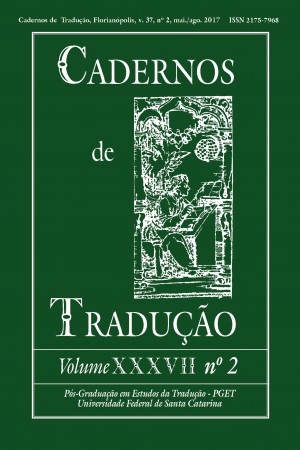Pierre Menard as logocentric translator: a reappraisal of Rosemary Arrojo’s analysis of “Pierre Menard, autor del Quijote”
DOI:
https://doi.org/10.5007/2175-7968.2017v37n2p55Abstract
This article revaluates Brazilian theorist Rosemary Arrojo’s reading of “Pierre Menard, autor del Quijote”, by Argentinian writer Jorge Luis Borges, proposing that her claims might be excessive, and calling into question the extent to which “Pierre Menard” can be read as a piece on translation. The first section briefly sketches deconstruction’s view on language and Arrojos’ own work; the second summarizes Arrojo’s analysis as contained in Oficina de tradução; the third exposes its limitations: its allegorical nature, its drawing upon a problematically amalgamating take on reading, interpretation and translation, the story’s difficult alignment with certain logocentric tenets and internal limitations of logocentrism’s take on language; the final section evaluates the role of George Steiner’s commentary on the short story as formative of the opinion that “Pierre Menard” is about translation.
Riferimenti bibliografici
ARROJO, Rosemary. Tradução, desconstrução e psicanálise. Rio de Janeiro: Imago, 1993.
ARROJO, Rosemay. Compreender x interpretar e a questão da tradução. In: ARROJO, Rosemay (org.). O Signo desconstruído: implicações para a tradução, a leitura e o ensino, 2.ed. Campinas: Pontes, 2003.
ARROJO, Rosemay. Oficina de tradução: a teoria na prática, 5.ed. São Paulo: Ática, 2007. (publ.or.1986.)
ARROJO, Rosemay. Translation, Transference, and the Attraction to Otherness: Borges, Menard, Whitman. In: Diacritics vol.34 n.030/4, Literary into Cultural Translation. Outono-inverno, 2004. pp.31-53.
BORGES, Jorge Luis. Pierre Menard, autor del Quijote. In: Obras completas I: 1923-1949, 5.ed. Barcelona: Emecé, 1996. pp.444-50.
BRITTO, Paulo Henriques. Desconstruir pra quê? In: Cadernos de tradução vol.02 n.08. Florianópolis, 2001. pp.41-50.
BÜHLER, Alex. Translation as interpretation. In: RICCARDI, Alessandra (ed.). Translation Studies: Perspectives on an Emerging Discipline. Cambridge University Press, 2002. pp.56-74.
ECO, Umberto. Interpretar não é traduzir. In: Quase a mesma coisa: experiências de tradução (trad. Eliana Aguiar; rev. trad. Rafaella de Filippis Quental). Rio de Janeiro & São Paulo: Record, 2007. pp.265-98.
GENTLZER, Edwin. Contemporary Translation Theories, 2.ed.rev. Clevedon, Buffalo, Toronto, Sydney: Multilingual Matters, 2001.
KRISTAL, Efraín. Invisible work: Borges and translation. Nashville: Vanderbilt University Press, 2002.
LOUIS, Anne-Marie. La traduction selon Jorge Luis Borges. In: Poétique n.107. Paris: Seuil, set/1996, pp.289-300.
PYM, Anthony. Exploring Translation Theories. Londres & Nova Iorque: Routledge, 2010.
ROUND, Nicholas. Translation and its Metaphors: the (N+1) wise men and the elephant. In: Skase Journal of Translation and Interpretation vol.01 n.01. The Slovak Association for the Study of English & University Library of Prešov University, 2005. pp.47-59. Available at http://www.skase.sk/Volumes/JTI01/doc_pdf/05.pdf.
STEINER, George. After Babel: Aspects of Language & Translation, 3.ed. Oxford University Press, 1998. (1.ed.1975.)
WAISMAN, Sergio. Borges y la traducción (trad. Marcelo Cohen). Buenos Aires: Adriana Hidalgo, 2005.
##submission.downloads##
Pubblicato
Come citare
Fascicolo
Sezione
Licenza
Autores têm autorização para assumir contratos adicionais separadamente, para distribuição não exclusiva da versão do trabalho publicada nesta revista (ex.: publicar em repositório institucional ou como capítulo de livro, com reconhecimento de autoria e publicação inicial nesta revista).





















































